Papers by Sanford Auerbach
Background: Despite high prevalence in the stroke population, sleep apnea is underdiagnosed. Obst... more Background: Despite high prevalence in the stroke population, sleep apnea is underdiagnosed. Obstructive sleep apnea is associated with poor cardiovascular outcomes and treatment with continuous po...
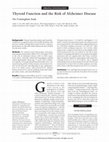
Background: Clinical hypothyroidism and hyperthyroidism are recognized causes of reversible demen... more Background: Clinical hypothyroidism and hyperthyroidism are recognized causes of reversible dementia, but previous studies relating thyrotropin levels to cognitive performance in clinically euthyroid persons have yielded inconsistent results. Methods: We related serum thyrotropin concentrations measured at baseline (March 1977-November 1979) to the risk of Alzheimer disease (AD) in 1864 cognitively intact, clinically euthyroid Framingham original cohort participants (mean age, 71 years; 59% women). Sex-specific Cox proportional hazards models were constructed using tertiles of thyrotropin concentration (tertile 2 as the referent) and adjusting for age, apolipoprotein E e4 allele status, educational level, plasma homocysteine level, current smoking, body mass index, prevalent stroke, and atrial fibrillation. Results: During a mean follow-up of 12.7 years (range, 1-25 years), 209 participants (142 women) developed AD. Women in the lowest (1.0 mIU/L) and highest (2.1 mIU/L) tertiles of...

OBJECTIVE: To test the hypothesis of whether slow wave sleep is protective against obstructive sl... more OBJECTIVE: To test the hypothesis of whether slow wave sleep is protective against obstructive sleep apnea. BACKGROUND: It is known that obstructive sleep apnea may worsen in REM stage of sleep as well as in supine sleep but limited data exist on the incidence of obstructive sleep apnea in the different NREM stages of sleep including N1, N2 and N3. There is limited data to support that obstructive sleep apnea improves in slow wave sleep. DESIGN/METHODS: A retrospective design study was conducted of the last 40 consecutive OSA patients who presented to the sleep lab. Data regarding medication use, Epworth, BMI, age were collected. The polysomnograms were analyzed for stages of sleep and the Apnea Hypopnea Index for REM, NREM, N1,N2 and N3 stage of sleep. The polysomnograms were scored using the American Academy of Sleep Medicine criteria. RESULTS: There were 40 patients with OSA. The mean AHI for the entire cohort was 24 events per hour. The AHI in REM sleep was 34 events per hour. T...
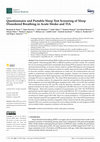
Journal of Clinical Medicine
Sleep disordered breathing (SDB) is highly prevalent, but frequently unrecognized among stroke pa... more Sleep disordered breathing (SDB) is highly prevalent, but frequently unrecognized among stroke patients. Polysomnography (PSG) is difficult to perform soon after a stroke. We evaluated the use of screening questionnaires and portable sleep testing (PST) for patients with acute stroke, subarachnoid hemorrhage, or transient ischemic attack to expedite SDB diagnosis and management. We performed a single-center retrospective analysis of a quality improvement study on SDB screening of consecutive daytime, weekday, adult admissions to a stroke unit. We excluded patients who were unable to communicate and lacked available family members. Patients were screened with the Epworth Sleepiness Scale, Berlin Questionnaire, and STOP-BANG Questionnaire and underwent overnight PST and/or outpatient PSG. The 4-item STOP Questionnaire was derived from STOP-BANG for a secondary analysis. We compared the sensitivity and specificity of the questionnaires for the diagnosis of at least mild SDB (apnea hypo...

Chronobiology International
ABSTRACT The continuous, longitudinal nature of accelerometry monitoring is well-suited to captur... more ABSTRACT The continuous, longitudinal nature of accelerometry monitoring is well-suited to capturing the regular 24-hour oscillations in human activity across the day, the cumulative effect of our circadian rhythm and behavior. Disruption of the circadian rhythm in turn disrupts rest-activity rhythms. Although circadian disruption is a major feature of Parkinson’s disease (PD), rest-activity rhythms and their relationship with disease severity have not been well characterized in PD. 13 PD participants (Hoehn & Yahr Stage [H&Y] 1–3) wore a Philips Actiwatch Spectrum PRO continuously for two separate weeks. Rest-activity rhythms were quantified by fitting an oscillating 24-hour cosinor model to each participant-day of activity data. One-way ANOVAs adjusted for demographics revealed significant variation in the amount (MESOR, F = 12.76, p < .01), range (Amplitude, F = 9.62, p < .01), and timing (Acrophase, F = 2.7, p = .05) of activity across H&Y Stages. Those with higher H&Y Stages were significantly more likely to be active later in the day, where-as those who shifted between H&Y Stages during the study were significantly more active than those who did not change H&Y Stage. Being active later in the day was also significantly associated with higher scores on the Movement Disorder Society’s Unified Parkinson’s Disease Rating Scale (MDS-UPDRS) Section III (motor symptom severity, p = .02), Section II (self-reported impact of motor symptoms on daily living, p = .01), and Total Score (p = .01) in an adjusted linear regression model; significant associations between MDS-UPDRS scores and activity levels were observed only in the unadjusted model. These findings demonstrate that continuous actigraphy is capable of detecting rest-activity disruption in PD, and provides preliminary evidence that rest-activity rhythms are associated with motor symptom severity and H&Y Stage.
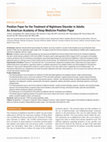
Journal of Clinical Sleep Medicine
Introduction: Nightmare disorder affects approximately 4% of adults, occurring in isolation or as... more Introduction: Nightmare disorder affects approximately 4% of adults, occurring in isolation or as part of other disorders such as posttraumatic stress disorder (PTSD), and can significantly impair quality of life. This paper provides the American Academy of Sleep Medicine (AASM) position regarding various treatments of nightmare disorder in adults. Methods: A literature search was performed based upon the keywords and MeSH terms from the Best Practice Guide for the Treatment of Nightmare Disorder in Adults that was published in 2010 by the AASM. The search used the date range March 2009 to August of 2017, and sought to find available evidence pertaining to the use of behavioral, psychological, and pharmacologic therapies for the treatment of nightmares. A task force developed position statements based on a thorough review of these studies and their clinical expertise. The AASM Board of Directors approved the final position statements. Determination of Position: Positions of "recommended" and "not recommended" indicate that a treatment option is determined to be clearly useful or ineffective/harmful for most patients, respectively, based on a qualitative assessment of the available evidence and clinical judgement of the task force. Positions of "may be used" indicate that the evidence or expert consensus is less clear, either in favor or against the use of a treatment option. The interventions listed below are in alphabetical order within the position statements rather than clinical preference: this is not meant to be instructive of the order in which interventions should be used. Position Statements: • The following therapy is recommended for the treatment of PTSD-associated nightmares and nightmare disorder: image rehearsal therapy. • The following therapies may be used for the treatment of PTSD-associated nightmares: cognitive behavioral therapy; cognitive behavioral therapy for insomnia; eye movement desensitization and reprocessing; exposure, relaxation, and rescripting therapy; the atypical antipsychotics olanzapine, risperidone and aripiprazole; clonidine; cyproheptadine; fluvoxamine; gabapentin; nabilone; phenelzine; prazosin; topiramate; trazodone; and tricyclic antidepressants. • The following therapies may be used for the treatment of nightmare disorder: cognitive behavioral therapy; exposure, relaxation, and rescripting therapy; hypnosis; lucid dreaming therapy; progressive deep muscle relaxation; sleep dynamic therapy; self-exposure therapy; systematic desensitization; testimony method; nitrazepam; prazosin; and triazolam. • The following are not recommended for the treatment of nightmare disorder: clonazepam and venlafaxine. • The ultimate judgment regarding propriety of any specific care must be made by the clinician, in light of the individual circumstances presented by the patient, accessible treatment options, and resources.
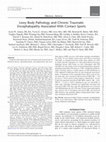
Journal of neuropathology and experimental neurology, 2018
Traumatic brain injury has been associated with increased risk of Parkinson disease and parkinson... more Traumatic brain injury has been associated with increased risk of Parkinson disease and parkinsonism, and parkinsonism and Lewy body disease (LBD) can occur with chronic traumatic encephalopathy (CTE). To test whether contact sports and CTE are associated with LBD, we compared deceased contact sports athletes (n = 269) to cohorts from the community (n = 164) and the Boston University Alzheimer disease (AD) Center (n = 261). Participants with CTE and LBD were more likely to have β-amyloid deposition, dementia, and parkinsonism than CTE alone (p < 0.05). Traditional and hierarchical clustering showed a similar pattern of LBD distribution in CTE compared to LBD alone that was most frequently neocortical, limbic, or brainstem. In the community-based cohort, years of contact sports play were associated with neocortical LBD (OR = 1.30 per year, p = 0.012), and in a pooled analysis a threshold of >8 years of play best predicted neocortical LBD (ROC analysis, OR = 6.24, 95% CI = 1.5-2...

Journal of clinical sleep medicine : JCSM : official publication of the American Academy of Sleep Medicine, Jan 15, 2017
Enuresis, or "bedwetting," in children is associated with obstructive sleep apnea (OSA)... more Enuresis, or "bedwetting," in children is associated with obstructive sleep apnea (OSA), and often resolves with treatment of OSA. However, it is poorly understood whether a similar relationship exists in adults. We describe a case series of 5 adult patients in whom OSA was diagnosed by laboratory polysomnography, who presented with enuresis that resolved after treatment with continuous positive airway pressure (CPAP). All cases occurred in the setting of obesity, in addition to other known risk factors for urinary incontinence and enuresis. OSA was diagnosed as severe in all but one case, which was mild. One patient noted recurrence of enuresis that coincided with malfunction of his CPAP machine. There is growing evidence that CPAP therapy may alleviate OSA and enuresis in adults with both conditions. Clinicians should routinely ask about enuresis in patients suspected of having OSA. A systematic study of the association between enuresis and OSA in adults is warranted.
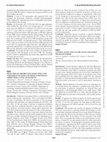
Sleep
regarding the relationship between the severity of OSA and gender on the level of HB. We aimed to... more regarding the relationship between the severity of OSA and gender on the level of HB. We aimed to examine their interaction effects on the level of HB in this work. Methods: A total of 859 participants with suspected OSA were included. All participants underwent overnight polysomnography (PSG) followed by examining the levels of hemoglobin and erythropoietin (EPO) in the morning. Results: Of all patients, 626 (72.9%) had OSA (an apnea-hypopnea index (AHI)≥5/h); 306 (35.6%) were women (age 46.7 ± 12.9 years, body mass index (BMI) 25.5 ± 4.0 kg/m 2), 523 (64.4%) were men (age 45.0 ± 11.7 years, BMI 26.2 ± 4.1 kg/m 2). ANOVA analysis revealed a significant interaction between AHI and gender on HB after adjusting for age, BMI, current smoking, drinking, and percentage of time spent in sleep below 90% oxygen saturation (F=6.87, p<0.01). For men, there were no differences in the level of HB among three groups with different levels of AHI (< 5/h, habitual snoring; 5-30/h, mild-moderate OSA; ≥ 30/h, severe OSA). For women, the level of HB in patients with severe OSA was significantly higher than those with habitual snoring and mild-moderate OSA. A cumulative association with AHI level and HB was only obtained in women (p<0.05 for linear trend), not in men. Conclusion: The results provide a novel evidence of mediated interaction between AHI and gender on the level of HB. The increasing severity of OSA is independently associated with a higher level of HB in women, but not in men.
Neurology
Go to Neurology.org for full disclosures. Funding information and disclosures deemed relevant by ... more Go to Neurology.org for full disclosures. Funding information and disclosures deemed relevant by the authors, if any, are provided at the end of the editorial.
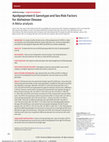
JAMA neurology, Jan 28, 2017
It is unclear whether female carriers of the apolipoprotein E (APOE) ε4 allele are at greater ris... more It is unclear whether female carriers of the apolipoprotein E (APOE) ε4 allele are at greater risk of developing Alzheimer disease (AD) than men, and the sex-dependent association of mild cognitive impairment (MCI) and APOE has not been established. To determine how sex and APOE genotype affect the risks for developing MCI and AD. Twenty-seven independent research studies in the Global Alzheimer's Association Interactive Network with data on nearly 58 000 participants. Non-Hispanic white individuals with clinical diagnostic and APOE genotype data. Homogeneous data sets were pooled in case-control analyses, and logistic regression models were used to compute risks. Age-adjusted odds ratios (ORs) and 95% confidence intervals for developing MCI and AD were calculated for men and women across APOE genotypes. Participants were men and women between ages 55 and 85 years. Across data sets most participants were white, and for many participants, racial/ethnic information was either not ...

Alzheimer's & dementia : the journal of the Alzheimer's Association, Jan 13, 2017
With a rapidly aging population, general practitioners are confronting the challenge of how to de... more With a rapidly aging population, general practitioners are confronting the challenge of how to determine those who are at greatest risk for dementia and potentially need more specialized follow-up to mitigate symptoms early in its course. We created a practical dementia risk score and provided individualized estimates of future dementia risk. Using the Framingham Heart Study data, we built our prediction model using Cox proportional hazard models and developed a point system for the risk score and risk estimates. The score system used total points ranging from -1 to 31 and stratifies individuals into different levels of risk. We estimated 5-, 10-, and 20-year dementia risk prediction and incorporated these into the points system. This risk score system provides a practical tool because all included predictors are easy to assess by practitioners. It can be used to estimate future probabilities of dementia for individuals.

Neurology, Jan 21, 2017
To evaluate the association between sleep duration and the risk of incident dementia and brain ag... more To evaluate the association between sleep duration and the risk of incident dementia and brain aging. Self-reported total hours of sleep were examined in the Framingham Heart Study (n = 2,457, mean age 72 ± 6 years, 57% women) as a 3-level variable: <6 hours (short), 6-9 hours (reference), and >9 hours (long), and was related to the risk of incident dementia over 10 years, and cross-sectionally to total cerebral brain volume (TCBV) and cognitive performance. We observed 234 cases of all-cause dementia over 10 years of follow-up. In multivariable analyses, prolonged sleep duration was associated with an increased risk of incident dementia (hazard ratio [HR] 2.01; 95% confidence interval [CI] 1.24-3.26). These findings were driven by persons with baseline mild cognitive impairment (HR 2.83; 95% CI 1.06-7.55) and persons without a high school degree (HR 6.05; 95% CI 3.00-12.18). Transitioning to sleeping >9 hours over a mean period of 13 years before baseline was associated wi...
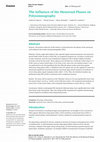
Cureus, 2016
Purpose: The primary objective of this study is to determine how the phases of the menstrual cycl... more Purpose: The primary objective of this study is to determine how the phases of the menstrual cycle influence the results of polysomnography (PSG). Methods: Twenty-eight adult subjects who reported regular menstrual periods, last menstrual period (LMP) within 26 days of their PSG, no exogenous hormone use, no history of polycystic ovarian syndrome, and who were scheduled for diagnostic PSG at Boston Medical satisfied inclusion criteria for the study. These subjects were divided into a Follicular Cohort (days 0-13 of the cycle) or Luteal Cohort (days 14-26 of the cycle), and a one-way analysis using a t-test was performed to test the hypothesis that the follicular phase confers protection against obstructive sleep apnea (OSA). A likelihood-ratio chi-square test was also applied to assess for a statistically significant association between menstrual stage and the presence of moderate-tosevere sleep apnea (apnea-hypopnea index (AHI) > 15/h). Thus, the statistical analysis was performed using AHI as both a continuous and a categorical outcome. Results: The mean AHI for patients in the Follicular Cohort (6.1/h) was significantly lower than the Luteal Cohort (14.3/h, p = 0.033). In the Follicular Cohort, 12% of patients had moderate to severe OSA. In the Luteal Cohort, 46% of patients had moderate to severe OSA (p = 0.045). Conclusions: Subjects undergoing PSG during the follicular phase have significantly lower AHIs than those in the luteal phase. Thus, the timing of PSG acquisition for regularly menstruating women should be considered when interpreting results.
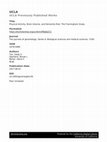
The Journals of Gerontology Series A: Biological Sciences and Medical Sciences, 2016
Background: Several longitudinal studies found an inverse relationship between levels of physical... more Background: Several longitudinal studies found an inverse relationship between levels of physical activity and cognitive decline, dementia, and/or Alzheimer's disease (AD), but results have been inconsistent. We followed an older, community-based cohort for over a decade to examine the association of physical activity with the risk of incident dementia and subclinical brain MRI markers of dementia. Methods: The physical activity index (PAI) was assessed in the Framingham Study Original and Offspring cohorts, aged 60 years or older. We examined the association between PAI and risk of incident all-cause dementia and AD in participants of both cohorts who were cognitively intact and had available PAI (n = 3,714; 54% women; mean age = 70 ± 7 years). We additionally examined the association between PAI and brain MRI in the Offspring cohort (n = 1,987). Results: Over a decade of follow-up, 236 participants developed dementia (188 AD). Participants in the lowest quintile of PAI had an increased risk of incident dementia compared with those in higher quintiles (hazard ratio [HR] = 1.50, 95% confidence interval [CI] = 1.04-1.97, p = .028) in a multivariable-adjusted model. Secondary analysis revealed that this relation was limited to participants who were apolipoprotein (APO)E ε4 allele noncarriers (HR = 1.58, 95% CI = 1.08-2.32; p = .018) and strongest in participants aged 75 years or older. PAI was also linearly related to total brain and hippocampal volumes (β ± SE = 0.24 ± 0.06; p < .01 and 0.004 ± 0.001; p = .003, respectively). Conclusion: Low physical activity is associated with a higher risk for dementia in older individuals, suggesting that a reduced risk of dementia and higher brain volumes may be additional health benefits of maintaining physical activity into old age.

Neurology, Feb 12, 2013
OBJECTIVE: To identify the prevalence of alpha-delta sleep in Postural Orthostatic Tachycardia Sy... more OBJECTIVE: To identify the prevalence of alpha-delta sleep in Postural Orthostatic Tachycardia Syndrome (POTS) patients. BACKGROUND: POTS is defined as symptomatic orthostatic intolerance associated with a heart rate increase of 30 bpm (or exceeding 120 bpm) occurring within the first 10 minutes of standing or upright tilt, that is not associated with other chronic debilitating conditions such as prolonged bed rest or the use of medications known to diminish vascular or autonomic tone. Patients with POTS complain of symptoms such as non-restorative sleep and daytime sleepiness. Alpha-delta sleep (ADS) is described as alpha wave intrusions in delta NREM (N3) sleep. ADS has been described in patients with fibromyalgia and depression – populations that share similar sleep complaints with POTS patients. We hypothesized that ADS would be observed in patients with POTS. DESIGN/METHODS: Polysomnograms from patients diagnosed with POTS (n=5, women=100%) were retrospectively analyzed by one sleep medicine specialist for the percent of delta waves with alpha intrusion during NREM sleep. Sleep efficiency and Epworth Sleepiness Scale (ESS) were also measured. None of the patients had a history of fibromyalgia or depression. RESULTS: All patients had alpha intrusions in N3 sleep. ADS constituted a mean of 7.22% with a range of 3-16% of N3 sleep. Sleep efficiency was decreased in all patients. Those with greater sleep efficiency had a lower percentage of ADS. No correlation was observed between ESS and ADS. CONCLUSIONS: ADS is an abnormal finding in sleep. To our knowledge this is the first description of presence of ADS in POTS patients. Daytime sleepiness did not correlate with ADS but an inverse correlation was noted between ADS and sleep efficiency. Further investigation is needed to characterize and evaluate the clinical implications given the limited sample size. Disclosure: Dr. Vaou has nothing to disclose. Dr. Westwood has nothing to disclose. Dr. Gorfinkel Pyatkevich has nothing to disclose. Dr. Auerbach has nothing to disclose. Dr. Hohler has received personal compensation for activities with Teva Neuroscience.
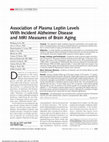
Jama the Journal of the American Medical Association, Dec 1, 2009
Context The adipokine leptin facilitates long-term potentiation and synaptic plasticity in the hi... more Context The adipokine leptin facilitates long-term potentiation and synaptic plasticity in the hippocampus, promotes -amyloid clearance, and improves memory function in animal models of aging and Alzheimer disease (AD). Objective To relate baseline circulating leptin concentrations in a community-based sample of individuals without dementia to incident dementia and AD during follow-up and magnetic resonance imaging (MRI) measures of brain aging in survivors. Design, Setting, and Participants Prospective study of plasma leptin concentrations measured in 785 persons without dementia (mean [SD] age, 79 [5] years; 62% female), who were in the Framingham original cohort at the 22nd examination cycle (1990-1994). A subsample of 198 dementia-free survivors underwent volumetric brain MRI between 1999 and 2005, approximately 7.7 years after leptin was assayed. Two measures of brain aging, total cerebral brain volume and temporal horn volume (which is inversely related to hippocampal volume) were assessed. Main Outcome Measure Incidence of dementia and AD during follow-up until December 31, 2007. Results During a median follow-up of 8.3 years (range, 0-15.5 years), 111 participants developed incident dementia; 89 had AD. Higher leptin levels were associated with a lower risk of incident dementia and AD in multivariable models (hazard ratio per 1-SD increment in log leptin was 0.68 [95% confidence interval, 0.54-0.87] for all-cause dementia and 0.60 [95% confidence interval, 0.46-0.79] for AD). This corresponds to an absolute AD risk over a 12-year follow-up of 25% for persons in the lowest quartile (first quartile) vs 6% for persons in the fourth quartile of sex-specific leptin levels. In addition, a 1-SD elevation in plasma leptin level was associated with higher total cerebral brain volume and lower temporal horn volume, although the association of leptin level with temporal horn volume did not reach statistical significance. Conclusion Circulating leptin was associated with a reduced incidence of dementia and AD and with cerebral brain volume in asymptomatic older adults.






Uploads
Papers by Sanford Auerbach